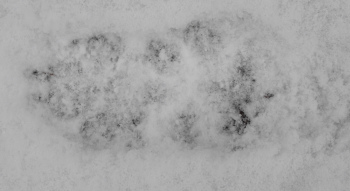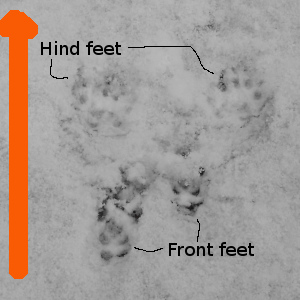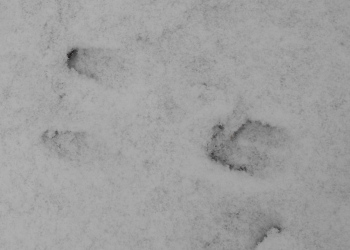
Farm Tracking 101, Part 3
 If you guessed dog for yesterday's mystery
track (shown here), you were right. It's actually two tracks on
top of each other, but not exactly registering, making the track look
longer than it actually is and muddying the shape. But the nails
in the front give it away. Domestic dog!
If you guessed dog for yesterday's mystery
track (shown here), you were right. It's actually two tracks on
top of each other, but not exactly registering, making the track look
longer than it actually is and muddying the shape. But the nails
in the front give it away. Domestic dog!
 Now to those pesky bounders. When I see
a set of two or four tracks together with a big space between, I
usually haul out my primary tracking tool --- the ruler. The
teensy tiny bounder tracks are shrews, mice, or voles. Next size
up comes chipmunks, then squirrels, then rabbits. Be sure to
measure both the length of the tracks and the space between each set of
tracks --- both are distinctive.
Now to those pesky bounders. When I see
a set of two or four tracks together with a big space between, I
usually haul out my primary tracking tool --- the ruler. The
teensy tiny bounder tracks are shrews, mice, or voles. Next size
up comes chipmunks, then squirrels, then rabbits. Be sure to
measure both the length of the tracks and the space between each set of
tracks --- both are distinctive.
Track placement is also important. Look at the set of four tracks
to the left (with the red arrow showing the direction of the animal's
movement.) The hind tracks are in front of the front tracks ---
odd, I know, but think about the way a rabbit looks as it hops, with
hind feet swinging  over past the front feet. That's normal
for all bounders.
over past the front feet. That's normal
for all bounders.
What helps you tell the bounder species apart is whether the front feet
tracks are staggered (like the ones above) or opposite (like the ones
to the right.) Squirrels keep their front feet paired while
rabbits and chipmunks tend to keep their front feet staggered. So
the track above is a chipmunk and the one to the right is a
squirrel.
| This post is part of our Farm Tracking 101 lunchtime series.
Read all of the entries: |
Want more in-depth information? Browse through our books.
Or explore more posts by date or by subject.
About us: Anna Hess and Mark Hamilton spent over a decade living self-sufficiently in the mountains of Virginia before moving north to start over from scratch in the foothills of Ohio. They've experimented with permaculture, no-till gardening, trailersteading, home-based microbusinesses and much more, writing about their adventures in both blogs and books.
Want to be notified when new comments are posted on this page? Click on the RSS button after you add a comment to subscribe to the comment feed, or simply check the box beside "email replies to me" while writing your comment.
